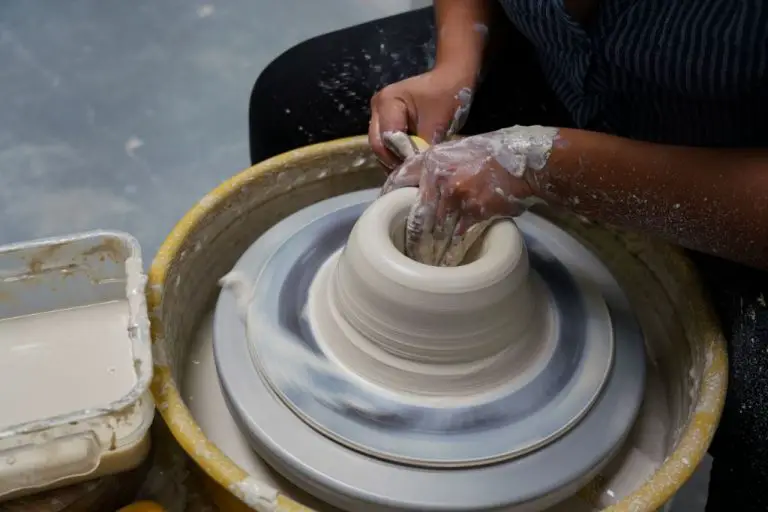What Instruments Can Be Made With Clay?
Clay instruments are musical instruments made primarily from hardened clay or ceramics. Clay is an excellent material for crafting instruments because of its versatility, affordability, and acoustic properties. Clay can be formed into a variety of shapes, cured at high temperatures to harden it, and decorated or glazed for aesthetic purposes.
The history of clay musical instruments dates back thousands of years across many cultures. Ancient pottery remains from Mesopotamia, Egypt, and the Indus Valley include whistles and ocarinas made of clay. Ceramic drums, rattles, and flutes have been found at archaeological sites around the world. Clay instruments continue to be popular today, with ocarinas, ukuleles, drums, and other instruments made from ceramic available from artisans and major musical instrument manufacturers.
Clay instruments produce sound through vibration, just like other musical instruments. The specific acoustic properties of clay, such as its density and rigidity, give it a unique tonality. Clay instruments can produce a wide range of sounds, from high pitches on flutes to low booming notes on drums. With creative shaping and glazing techniques, clay instruments can also have distinctive visual appeal.
Wind Instruments
Wind instruments made of clay are some of the most popular and widely used. Clay is an ideal material for wind instruments because of its natural acoustic properties. Three of the main types of clay wind instruments are ocarinas, whistles, and flutes.
Ocarinas are ancient flute-like instruments that are shaped like an elongated oval. They have between 4-12 finger holes and are played by blowing into the mouthpiece and covering different holes to produce notes. Ocarinas made of clay produce a very pure, rounded, and sweet tone. They were originally developed in South America over 12,000 years ago and are now popular worldwide.
Whistles are simple instruments made of clay that produce sound from a stream of air. There are two main types – vessel whistles that contain chambers and tubes, and fipple whistles that contain a fipple mouthpiece to direct the air over an edge. Whistles can create various pitches and tones depending on their shape and size. They are easy to play and often used for signaling and ceremonies.
Flutes have been made from clay for thousands of years. Clay flutes produce soft, warm, and mellow tones that many musicians prefer over metal flutes. There are several types of clay flutes including the recorder, pan flute, and nose flute. High quality clay flutes require skill to construct in order to achieve the proper tuning and tone.
String Instruments
String instruments made of clay have been around for thousands of years. Two of the most popular and historically significant are lutes and harps.
Lutes
Lutes are plucked string instruments with long, fretted necks and rounded bodies. They originated over 3,000 years ago in ancient Mesopotamia and Egypt. Clay lutes were very common, though over time wood gradually became the preferred material. The oud is a short-necked lute which remains popular in North Africa and the Middle East.
Harps
Harps are open-framed instruments with strings running perpendicular to the soundboard. They have been used since prehistoric times, with depictions found in ancient Egyptian and Mesopotamian artifacts. Clay harps are still played in parts of Africa and South America. The best known is the Peruvian arpa, a boat-shaped harp with a curved forepillar for tuning pegs.
Percussion Instruments
Percussion instruments made from clay create a warm and earthy sound. Clay is an ideal material for making drums, shakers and rainsticks that provide rhythmic accompaniment for music.
Drums
Drums made from clay have a deep, resonate sound. They can be made in many shapes and sizes, from small hand drums to large barrel drums. Fired clay drums are durable, and when struck with hands or mallets produce a variety of tones. Drum heads can be made from animal hide or wood to modify the sound.
Shakers
Clay shakers come in many shapes like balls, tubes and vessels. Small pebbles, beads or seeds are placed inside the hollow clay form to create unique sounds when shaken. The size and amount of internal materials impacts the shaker’s volume and pitch. Decorative patterns and symbols can be painted or etched on the outer clay surface.
Rainsticks
Rainsticks are long hollow tubes made from clay that are filled with small items like seeds or rice. When tipped vertically, the items cascade down the inside walls imitating the sound of rain falling. The length of the tube impacts the rainstick’s pitch and duration of sound. Intricate designs can be carved or painted on the outer surface.
Making Clay Instruments
Making musical instruments out of clay requires some basic knowledge of ceramic shaping and firing techniques. The process starts with choosing an appropriate clay body that is sturdy yet responsive. Stoneware and earthenware clays are common choices as they provide good acoustic properties after firing.
Shaping the instrument begins by wedging the clay to remove air bubbles. Then the basic form can be shaped using a variety of handbuilding techniques like pinch pots, slabs, or coils. Smooth sculpting tools can refine the shapes. Careful measuring and symmetry is important to achieve the right tones and pitches. Complex or hollow forms may require bisque firing the clay pieces separately before final assembly.
Firing transforms the soft clay into a hard, permanent material. Low fire clays can be fired in a kiln at lower temperatures, while high fire clays require hotter kilns exceeding 2,200°F. Multiple thin layers of ceramic glazes can be applied before firing to create colors and effects. Glazes often contain metal oxides and minerals that vitrify as glossy glassy finishes.
Finally, accessories like mouthpieces or drumheads can be added after firing. Clay strap-on or inserted mouthpieces let flutes, ocarinas, and whistles be played. Stretched hide or skin drumheads are common for hand drums and percussion. Other options include wood, metal, or bone parts incorporated into the design.
The Science of Clay Instruments
Clay instruments produce sound through vibrations, just like other musical instruments. When an instrument is played, it creates vibrations that cause waves of air pressure that travel into our ears. These air pressure waves stimulate the ear drum and are interpreted by our brain as sound.
The science behind how clay instruments produce different pitches and tones has to do with the acoustics. Acoustics refers to how sound behaves in an enclosed space. The size and shape of a clay instrument impacts the acoustics and resonance inside the instrument. This affects the wavelengths and frequencies that are amplified when the instrument vibrates, resulting in high or low pitches.
For example, a long thin clay flute will vibrate to produce relatively longer wavelengths at lower frequencies, creating lower pitches. A short fat clay ocarina resonates with shorter wavelengths at higher frequencies, creating higher pitches. Skilled clay instrument makers carefully design the structure to achieve the desired pitch and tone.
The material composition of the clay also impacts the sound. Denser clay with thinner walls tends to produce brighter, louder tones. The quality of the clay along with the instrument design allows clay instruments to produce a wide range of beautiful pitches and tones.
Popular Clay Instruments
Some of the most popular and widely recognized clay instruments include:
Ocarinas
Ocarinas are an ancient wind instrument typically made from clay or ceramic. They are one of the earliest melody instruments and date back over 12,000 years. Ocarinas are oval or egg-shaped with holes that the player covers to produce different tones and pitches.
Udu drums
Udu drums originated in Nigeria and are made from clay pots with an opening at the top. The player taps and slaps different parts of the drum to create a variety of percussive sounds. Udu drums produce both high and low pitches.
Xun
The xun is a globular Chinese ocarina made of baked clay. It has a blow hole on top and finger holes on the bottom. Xuns produce a soft, melancholic tone and have been played for over 7,000 years in China.
Rainstick
Rainsticks are long, hollow tubes made from clay and filled with pebbles or beans. Tilting the rainstick makes the pebbles fall and strike the sides, mimicking the sound of falling rain. Rainsticks are simple percussion instruments used by many cultures.
Clay Instruments in Culture
Clay instruments have a long and storied history in many cultures around the world. Tracing back thousands of years, clay instruments emerged independently across ancient civilizations as an accessible and creative musical medium.
The ocarina, one of the most popular and recognizable clay instruments, has its roots in Mesoamerica and South America, used extensively in indigenous music and ceremonies. Chinese xun flutes, another ancient clay instrument, date back over 7000 years and hold deep symbolic meaning in Chinese culture.
In Africa, ceramic drums and horns crafted from clay have an important role in traditional and folk music. The West African dondo and udu are distinctive percussion instruments with symbolic ties to spirituality and community.
Beyond music, clay instruments often carry cultural meaning related to spirituality, celebration, mourning, or community events. Their earthy material connects them to nature and creation myths in some cultures. passing down clay instruments and songs also represents cultural heritage and ancestral knowledge.
Today, while invented traditions blur some origins, clay instruments remain woven into the fabric of many cultures. Their sound and symbolism continue to breathe life into ancient traditions. Modern artists also reinterpret them, shaping clay into new experimental forms.
Notable Clay Instrument Artists
Clay instruments have been around for thousands of years, but it’s the modern masters who have really pushed the artform forward. Artists like Magdalena Suarez Frimkess and Peter Voulkos pioneered new techniques in the mid-20th century that opened up new possibilities for ceramic instruments.
Frimkess invented the clay oscillator in the 1960s, an ingenious free-hanging slab that produces sound when struck. This technique for building sound directly into clay structures was an important innovation that many ceramic artists still utilize today. Voulkos, often called the father of the abstract expressionist ceramic movement, was known for his enormous, rough-hewn clay sculptures that challenged the convention of ceramic craft. His large pieces incorporated principles of sound design that were unprecedented.
Contemporary artists are continuing to innovate and push boundaries. Japanese-American artist Suzi Shara creates otherworldly flutes and horns inspired by science fiction. Miranda Donovan engineers complex clarinets and entire orchestras out of paper-thin colored porcelain. Both build sound into imaginative new forms and vessels, unlocking fresh potential from one of humankind’s oldest creative mediums. The future of clay instruments promises to be as rich and vibrant as its storied past.
Conclusion
We’ve explored a range of amazing instruments that can be made from clay, from whistles and flutes to string and percussion instruments. While relatively simple, clay instruments have a rich history across many cultures. Clay allows everyday people to craft musical tools using accessible materials. From ocarinas in ancient societies to modern experimental clay designs, these instruments continue to capture imaginations.
Looking forward, we may see even more innovations in clay instruments as technology advances. With 3D printing, it’s possible to design intricately shaped clay instruments. We may also discover new acoustic properties of clay through materials science. Yet some traditions remain timeless – clay whistles made by children, or the tranquil sounds of a ceramic ocarina. The simplicity and creativity of clay instruments ensure their place in human culture for generations to come.



